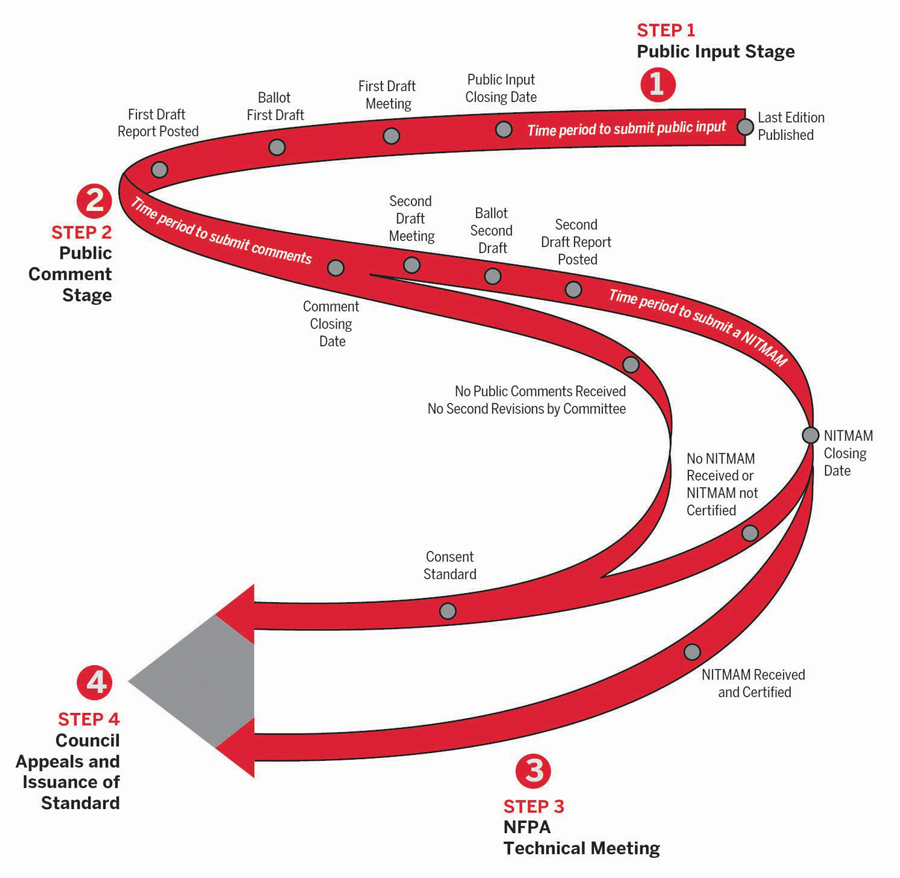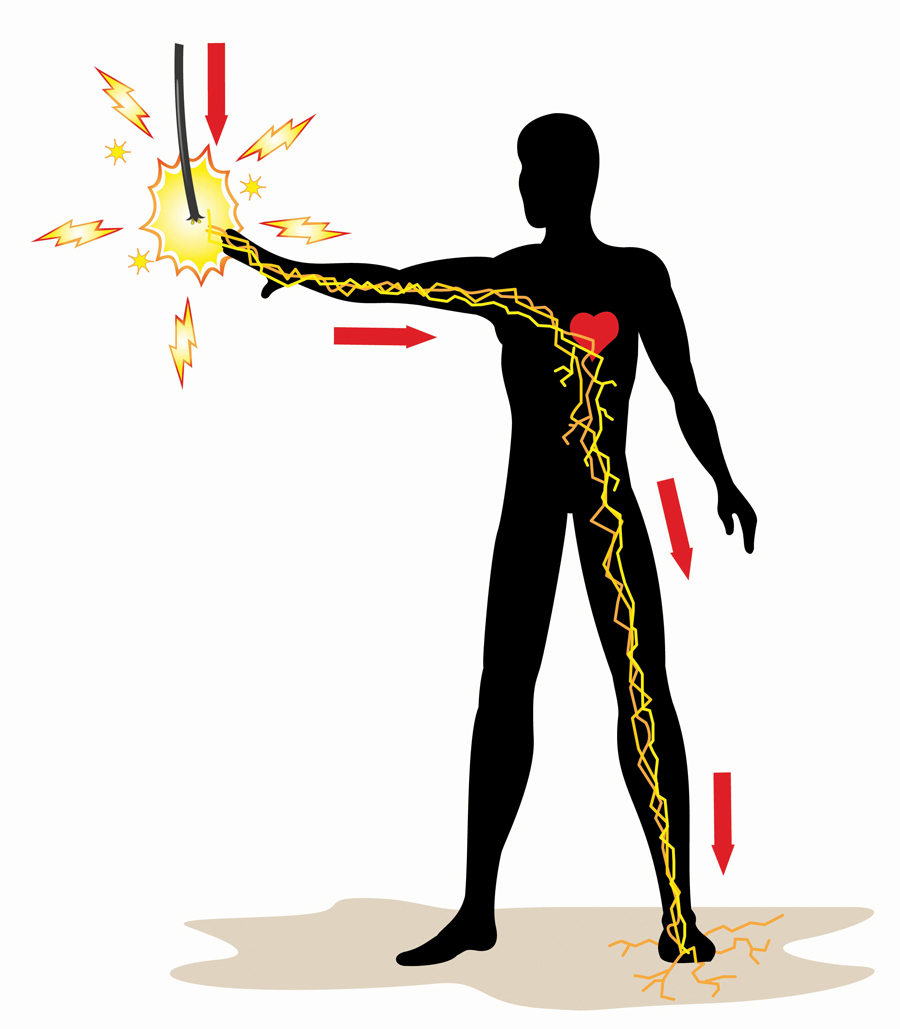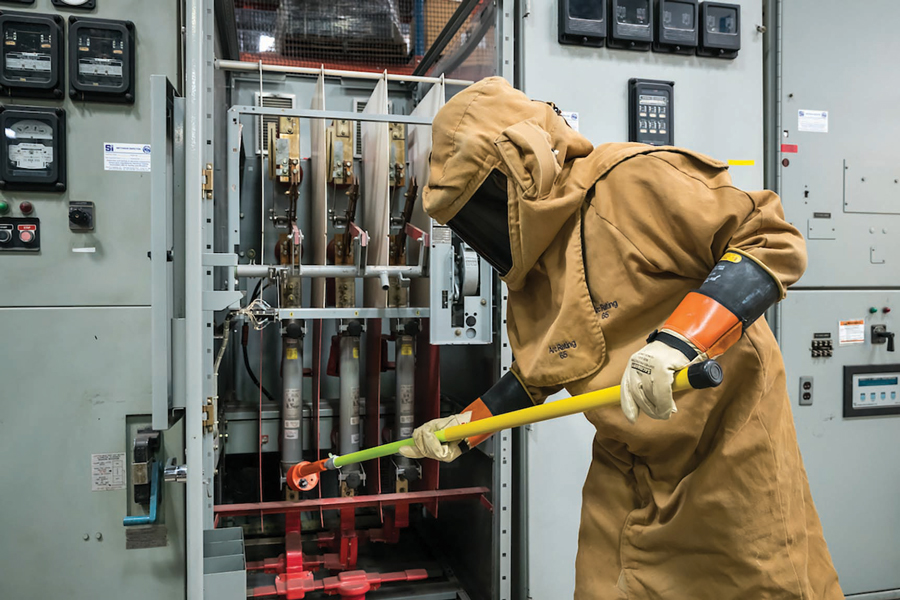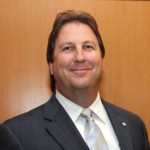In late August 2022, the NFPA 70E Technical Committee met for the Second Draft meeting related to the revision of what will be the 2024 edition of NFPA 70E, Standard for Electrical Safety in the Workplace.

Figure 1: NFPA Standards Process
This was the step in the revision process where the 70E Technical Committee meets to review Public Comments as well as NFPA Correlating Committee comments related to proposed changes to the standard. The NFPA consensus process is very thorough, allowing full public input and comment on committee actions.
As a reminder, the standards revision process is generally a four-step process, and NFPA provides a summary.
Step One: Public Input
Following the publication of the current edition of an NFPA standard, the development of the next edition begins, starting with the acceptance of Public Input for changes to the document.
After receiving input from the public, a First Draft meeting of the Technical Committee is held, and the committee considers the input and provides a response. The responses are balloted, and a report of the ballot and any committee comments is published in the form of a First Draft report. This is the beginning of change to what will become the newly formed standard content.
Step Two: Public Comment
After the first draft report is published, anyone may submit a Public Comment in the form of suggested text on the First Draft. From here, the Technical Committee calls a Second Draft meeting to review any suggested comments from the public. These actions are recorded and balloted by the Technical Committee, and a Second Draft report is generated for review by the public.
*Note: This is where we currently are in the NFPA 70E, 2024 Edition, revision process.
Step Three: NFPA Technical Meeting
Following completion of the Public Input and Public Comment stages, there is further opportunity for debate and discussion of any unresolved issues at the NFPA Technical Meeting held during the NFPA Conference & Expo each June. The next meeting will be held in Las Vegas, June 19–23, 2023.
Prior to the meeting, if someone still has an issue they want to bring forth, they must file a notice of intent to make a motion or NITMAM.
A NITMAM is a proposed amending motion for NFPA membership consideration and debate at the NFPA Technical Meeting. These motions are attempts to amend the committee’s recommended text published as the Second Draft.
Allowable motions include:
- Motions to accept Public Comments in whole or in part
- Motions to reject a Second Revision (change accepted by the committee) in whole or part
- Motions to accept committee comments in whole or in part
- Motions to reject a Second Revision (change accepted by the committee) in whole or part and can include the related portions of First Revisions
In addition, under certain specified instances, motions can be made to return an entire NFPA Standard to the committee. If successful, the Standard will not be issued and will be returned to the committee to continue its work.
Step Four: Council Appeals and Issuance of Standard
One of the primary responsibilities of the NFPA Standards Council, as the overseer of the NFPA standards development process, is to act as the issuer of NFPA standards.
The Standards Council considers any appeals that have been made, and after deciding all appeals related to a standard, the Standards Council, if appropriate, proceeds to issue the document as an official NFPA standard.
The new NFPA standard becomes effective 20 days after the Standards Council’s action of issuance. In the case of NFPA 70E, that most likely will be in July 2023.
An important note: When NFPA 70E is issued and an effective date is determined, this is the date at which the standard is applicable and will supersede all previous editions. Because it is a work practices document, the effective date of the new standard constitutes the rules and requirements going forward, so it’s important to understand any changes that were made to the new standard.
HIGHLIGHTS OF THE SECOND DRAFT MEETING
Several hundred Public Comments were processed during the recent Second Draft meeting. Some were technical; some were related to structure in accordance with NFPA’s Style Manual; some were directed to the Technical Committee by NFPA’s Correlating Committee.
All of them received thorough review, analysis, and discussion, which reinforces the effectiveness of the consensus process, ultimately leading to the production of the revised standard.
Global Change: Electric Shock
To ensure consistent use of the term and as a global change, any time* the word “shock” was used, we added the word “electric” in front of it.
* There are two terms — “hearing protection boundary” and “lung protection boundary” — where the definitions use “shock” in a different context, i.e., “shock wave.” These were not changed.

Figure 2: Electric Shock
Section No. 90.5(C) Explanatory Material
A sentence was added to 90.5(C) to clarify the use of other standards as a reference:
Unless the standard reference includes a date, the reference is to be considered as the latest edition of the standard.
Point being, unless indicated otherwise, always consider the latest edition of any referenced standard when using the 70E!
Article 100 Definitions: Electrically Safe Work Condition
In one of the most important definitions in the standard, a slight change was made with regard to terminology around testing for the absence of voltage. The words “to verify” were replaced with “for” to be consistent with how the process of establishing and verifying an electrical safe work condition is described in120.6(7). It is a small, but important, change!
Electrically Safe Work Condition.
A state in which an electrical conductor or circuit part has been disconnected from energized parts, locked/tagged in accordance with established standards, tested to verify for the absence of voltage, and, if necessary, temporarily grounded for personnel protection.

Figure 3: Absence of Voltage
Article 100 Definitions: Boundaries Abound
There are five boundary definitions to be aware of:
- Arc flash boundary
- Hearing protection boundary*
- Limited approach boundary
- Lung protection boundary*
- Restricted approach boundary
*The hearing and lung protection boundaries are referenced in Article 360, Safety-Related Requirements for Capacitors.

Article 105 Application of Safety-Related Work Practices and Procedures
Besides adding the words “Application of” to the title, the purpose of Section 105 was updated to the following:
105.2 Purpose.
These practices and procedures are intended to provide for employee safety reduce the risk for employees relative to electrical hazards in the workplace.
This update was made so that describing the purpose of the standard in terms of risk reduction is consistent with the risk assessment and control requirements of the document.
Section 110.4(A) Electrical Safety Training (1) Qualified Person
Text was deleted in this section as the wording was redundant.
(b) A person shall be permitted to be qualified for some equipment or tasks and not others.
Section 250.2 Maintenance Requirements for Personal Safety and Protective Equipment
The term “hot sticks,” which arguably is a slang term, was clarified, and the term “live line tools” is used throughout the standard.
(2) Hot sticks (live line tools)
The addition of “live line tools” was added to include the correct technical term.
NEC STYLE MANUAL COMPLIANCE
There were many revisions to the standard to correct wording and terminology so that it complies with 2020 NEC Style Manual. It is important that sentence structure and organization is consistent between NFPA standards, and many editorial corrections were made to the 2024 edition to comply with the Style Manual.
SUMMARY: WHY DO WE CARE ABOUT NFPA 70E?
Many subject matter experts and volunteers work to develop consensus standards, and the rules, procedures, and guidance outlined in NFPA 70E are very purposeful and structured, allowing for public input and change. But why do we care?
Simply put — to save lives and avoid injury! NFPA 70E is a resource to help companies and employees reduce exposure to risks and reduce occupational injuries and fatalities. It was created to provide a document that meets Occupational Safety and Health Administration (OSHA) requirements and is entirely consistent with the NEC and other applicable publications.
NFPA 70E is a great resource to keep your employees safe as we deal with the hazards of electricity. So buy the new edition when it comes out and familiarize yourself with the words and terms, new and existing, of this very important safety standard.
And before you work on it — turn it off!
 Ron Widup is the Vice Chairman, Board of Directors, and Senior Advisor, Technical Services for Shermco Industries and has been with Shermco since 1983. He is a member of the NETA Board of Directors and Standards Review Council; a Principal member of the Technical Committee on Standard for Electrical Safety in the Workplace (NFPA 70E); Principal member of the National Electrical Code (NFPA 70) Code Panel 11; Principal member and Chairman of the Technical Committee on Standard for Competency of Third-Party Evaluation Bodies (NFPA 790); Principal member and Chairman of the Technical Committee on Recommended Practice and Procedures for Unlabeled Electrical Equipment Evaluation (NFPA 791); a member of the Technical Committee Recommended Practice for Electrical Equipment Maintenance (NFPA 70B); and Vice Chair for IEEE Std. 3007.3, Recommended Practice for Electrical Safety in Industrial and Commercial Power Systems. He is a member of the Texas State Technical College System (TSTC) Board of Regents, a NETA Certified Level 4 Senior Test Technician, State of Texas Journeyman Electrician, a member of the IEEE Standards Association, an Inspector Member of the International Association of Electrical Inspectors, and an NFPA Certified Electrical Safety Compliance Professional (CESCP).
Ron Widup is the Vice Chairman, Board of Directors, and Senior Advisor, Technical Services for Shermco Industries and has been with Shermco since 1983. He is a member of the NETA Board of Directors and Standards Review Council; a Principal member of the Technical Committee on Standard for Electrical Safety in the Workplace (NFPA 70E); Principal member of the National Electrical Code (NFPA 70) Code Panel 11; Principal member and Chairman of the Technical Committee on Standard for Competency of Third-Party Evaluation Bodies (NFPA 790); Principal member and Chairman of the Technical Committee on Recommended Practice and Procedures for Unlabeled Electrical Equipment Evaluation (NFPA 791); a member of the Technical Committee Recommended Practice for Electrical Equipment Maintenance (NFPA 70B); and Vice Chair for IEEE Std. 3007.3, Recommended Practice for Electrical Safety in Industrial and Commercial Power Systems. He is a member of the Texas State Technical College System (TSTC) Board of Regents, a NETA Certified Level 4 Senior Test Technician, State of Texas Journeyman Electrician, a member of the IEEE Standards Association, an Inspector Member of the International Association of Electrical Inspectors, and an NFPA Certified Electrical Safety Compliance Professional (CESCP).
